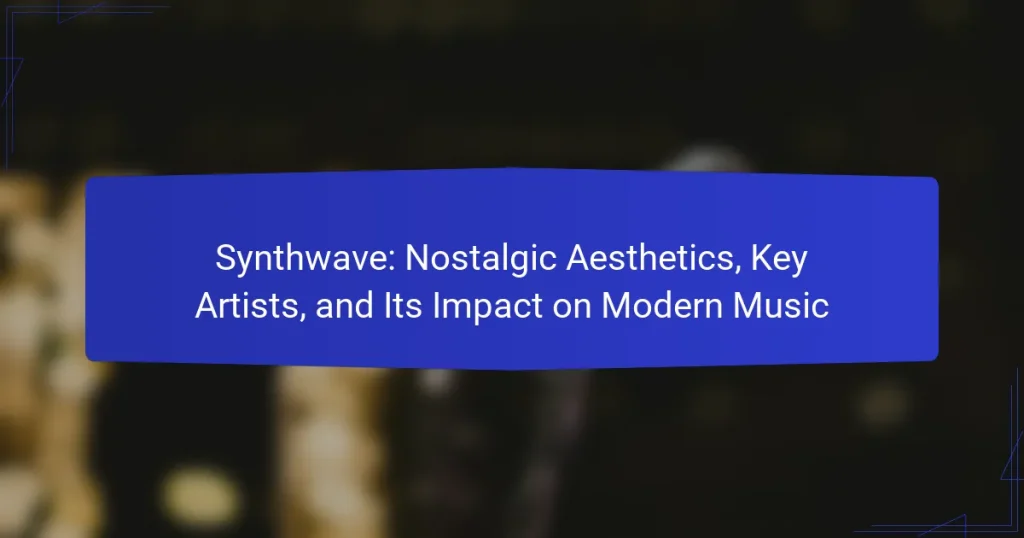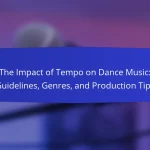Synthwave is a music genre that emerged in the late 2000s, inspired by 1980s synthesizer-driven music and pop culture. Characterized by nostalgic soundscapes and retro-futuristic aesthetics, it incorporates elements from electronic, disco, and new wave music. Key artists such as Kavinsky, Gunship, and The Midnight have popularized the genre, which reflects a cultural longing for the past while utilizing modern production techniques. Synthwave has significantly influenced contemporary music and culture, inspiring artists across various genres and permeating fashion, film, and video games with its distinctive sound and visuals. The genre has also fostered a dedicated community that celebrates retro culture, evident in the resurgence of vintage synthesizers and cassette tapes.
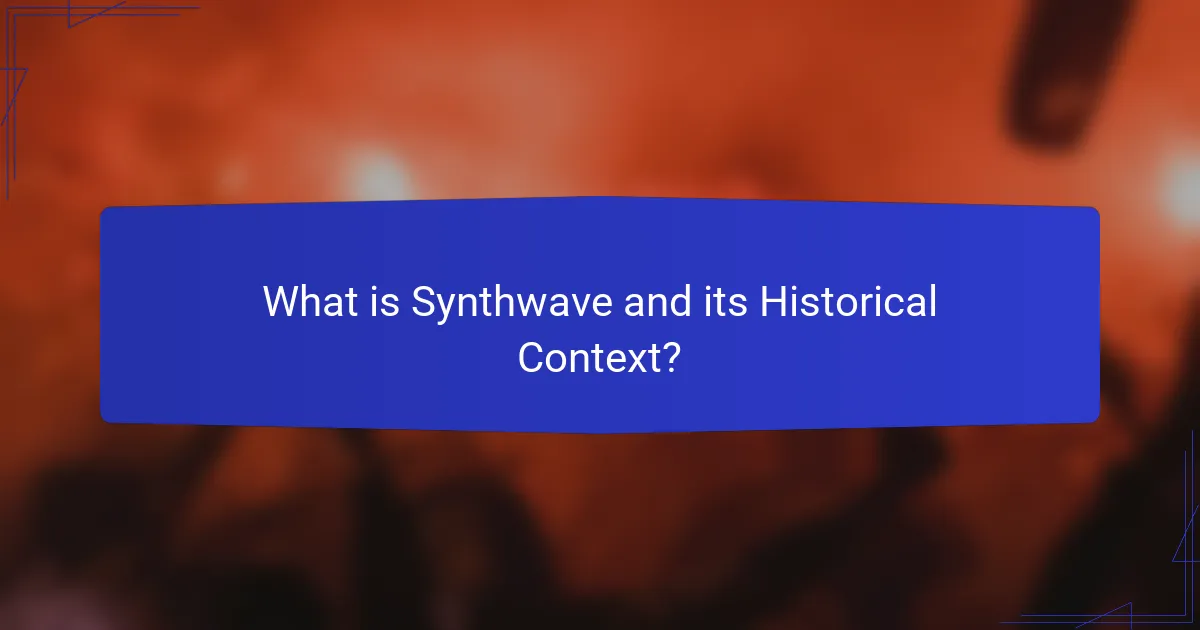
What is Synthwave and its Historical Context?
Synthwave is a genre of music that draws inspiration from 1980s synthesizer-driven music and pop culture. It emerged in the late 2000s, characterized by its nostalgic soundscapes and retro-futuristic aesthetics. The genre often incorporates elements from electronic, disco, and new wave music. Key influences include film soundtracks, video games, and the visual styles of the 1980s. Artists like Kavinsky and Gunship have popularized the sound. The genre reflects a cultural longing for the past, blending modern production techniques with vintage sounds. Its growth coincided with the rise of digital platforms, enabling wider access and distribution. Synthwave has significantly impacted contemporary music, inspiring new artists and genres.
How did Synthwave emerge as a musical genre?
Synthwave emerged as a musical genre in the late 2000s. It draws inspiration from 1980s music, films, and video games. Artists sought to recreate the sounds and aesthetics of that era. The genre combines electronic music with retro synth sounds. Key influences include synth-pop, new wave, and electronic dance music. The internet played a crucial role in its rise, facilitating community and sharing. Platforms like Bandcamp and SoundCloud helped artists reach wider audiences. By the 2010s, Synthwave gained significant popularity, with notable artists like Kavinsky and Gunship. Its nostalgic appeal resonates with both older and younger generations.
What cultural movements influenced the birth of Synthwave?
Synthwave was influenced by several cultural movements, primarily the 1980s pop culture, retro futurism, and the rise of digital technology. The 1980s pop culture provided a nostalgic aesthetic through films, video games, and music associated with that era. Retro futurism contributed to the visual style of Synthwave, emphasizing neon colors and cyberpunk themes. The emergence of digital technology allowed artists to create music reminiscent of vintage synthesizers and electronic sounds. Additionally, the DIY ethos of the internet age enabled independent artists to share their work and connect with audiences, further fueling the growth of the genre.
How does Synthwave relate to the retro aesthetics of the 1980s?
Synthwave is a music genre that embodies the retro aesthetics of the 1980s. It draws heavily from the sounds, visuals, and cultural elements of that era. Synthwave incorporates synthesizers, drum machines, and nostalgic melodies reminiscent of 1980s pop and electronic music. The genre often features neon colors and retro-futuristic imagery in its artwork, reflecting the visual style of 1980s movies and video games. Key artists like Kavinsky and Gunship channel this aesthetic through their music and visuals. The resurgence of 1980s style in modern media, such as films and video games, further solidifies Synthwave’s connection to that decade. This genre serves as a tribute to the past while influencing contemporary music trends.
What are the defining characteristics of Synthwave music?
Synthwave music is characterized by its nostalgic sound that draws inspiration from the 1980s. It typically features synthesizers, drum machines, and retro-futuristic elements. The genre often incorporates melodic hooks and ambient textures. Synthwave is known for its cinematic quality, evoking a sense of nostalgia for 80s pop culture. Artists often use vibrant, neon colors in visual aesthetics to complement the music. The genre has gained popularity through film soundtracks and video games. Key artists include Kavinsky, Gunship, and The Midnight. Synthwave reflects a blend of electronic, pop, and cinematic influences, creating a unique auditory experience.
What instruments and technology are commonly used in Synthwave?
Synthwave commonly utilizes synthesizers, drum machines, and samplers. Key instruments include the Roland Juno-106 and Yamaha DX7 synthesizers. Drum machines like the Roland TR-808 and TR-909 are frequently used for rhythmic elements. Samplers, such as the Akai MPC series, provide additional sound manipulation. Technology often involves digital audio workstations (DAWs) like Ableton Live or FL Studio for production. Effects processors and plugins enhance sound design with reverb and chorus effects. The genre emphasizes retro sounds, drawing from 1980s music technology. This combination creates the nostalgic feel characteristic of Synthwave.
How do Synthwave melodies and rhythms differentiate it from other genres?
Synthwave melodies and rhythms are characterized by their retro-futuristic sound. They often incorporate synthesizers, drum machines, and nostalgic elements from the 1980s. This genre utilizes lush, melodic lines that evoke a sense of nostalgia. Rhythms in Synthwave are typically steady and danceable, often featuring four-on-the-floor beats.
The use of arpeggiated synth patterns is prevalent, creating a dreamy atmosphere. Additionally, Synthwave frequently employs cinematic soundscapes, enhancing its emotional impact. Unlike other genres, it emphasizes a blend of electronic and pop influences. The combination of these elements creates a sound distinctly different from rock, hip-hop, or classical music.
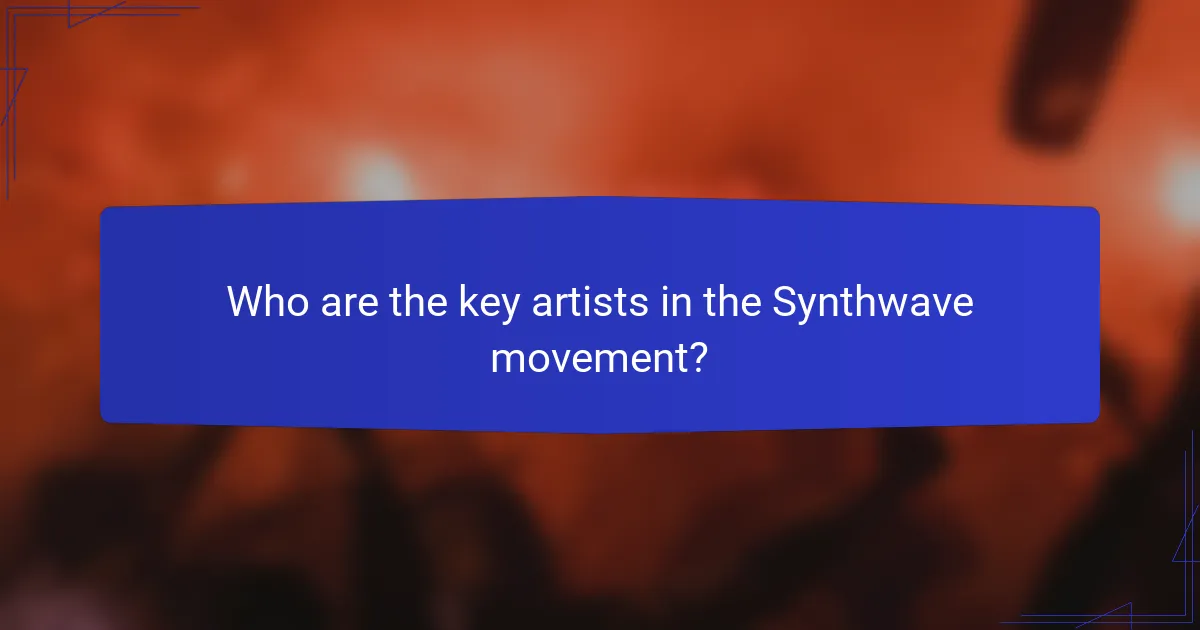
Who are the key artists in the Synthwave movement?
Key artists in the Synthwave movement include Kavinsky, Gunship, and The Midnight. Kavinsky gained fame with his track “Nightcall,” featured in the film “Drive.” Gunship is known for their cinematic sound and retro visuals. The Midnight combines nostalgic synths with modern pop elements. Other notable artists are FM-84 and Timecop1983, both contributing to the genre’s distinctive sound. These artists are recognized for their ability to evoke 1980s nostalgia through music and aesthetics.
Which artists are considered pioneers of Synthwave?
Artists considered pioneers of Synthwave include Kavinsky, College, and FM-84. Kavinsky gained recognition with his hit “Nightcall” in 2010. College’s track “A Real Hero,” featured in the film “Drive,” helped popularize the genre. FM-84 is known for their nostalgic sound and the album “Atlas,” released in 2016. These artists are instrumental in shaping the Synthwave sound and aesthetic. Their contributions have established a foundation for the genre’s growth and influence in modern music.
What contributions did these artists make to the genre?
These artists significantly shaped the synthwave genre through their innovative sounds and nostalgic aesthetics. They incorporated elements from 1980s pop culture, including retro synthesizers and drum machines. Their music often evokes feelings of nostalgia, appealing to both new listeners and those familiar with the era. Notable artists like Kavinsky and Perturbator have created iconic tracks that define the genre’s sound. Their work has influenced contemporary artists across various music genres. Additionally, they have contributed to the visual aspect of synthwave through striking album art and music videos that reflect retro-futuristic themes. This fusion of music and visual art has solidified synthwave’s place in modern music culture.
How have newer artists shaped the evolution of Synthwave?
Newer artists have significantly shaped the evolution of Synthwave by introducing fresh sounds and diverse influences. They blend traditional Synthwave elements with modern genres like trap, pop, and indie rock. This fusion creates a more varied sound palette, appealing to a broader audience. Artists such as The Midnight and Gunship have incorporated live instrumentation, enhancing the genre’s depth. Additionally, newer artists often utilize digital platforms for distribution, increasing accessibility and reach. Collaborations across genres have also become common, further expanding Synthwave’s boundaries. This evolution reflects a shift towards a more inclusive and innovative musical landscape.
What role does collaboration play among Synthwave artists?
Collaboration among Synthwave artists fosters creativity and innovation. It allows artists to blend their unique styles and influences. This synergy often results in tracks that resonate more with audiences. Collaborations can also expand the reach of individual artists. By working together, they tap into each other’s fan bases. Notable collaborations have led to successful projects and increased visibility. For instance, artists like The Midnight and Timecop1983 have produced popular collaborative works. These partnerships enhance the genre’s diversity and appeal. Overall, collaboration is essential for growth and evolution in the Synthwave community.
How do collaborations influence the sound and reach of Synthwave music?
Collaborations significantly enhance the sound and reach of Synthwave music. They introduce diverse influences and styles that enrich the genre’s sonic palette. Collaborations often merge the distinct sounds of different artists, creating innovative tracks that appeal to a broader audience. For instance, when prominent Synthwave artists work with musicians from other genres, they infuse fresh elements into their music. This blending of styles can attract fans from various musical backgrounds. Additionally, collaborations can leverage each artist’s fanbase, amplifying the exposure of the resulting music. Notable examples include collaborations between Synthwave artists and electronic or pop musicians, which have led to chart-topping hits. These partnerships often result in unique soundscapes that push the boundaries of traditional Synthwave. Overall, collaborations play a crucial role in evolving the genre and expanding its listener base.
What notable collaborations have emerged within the Synthwave community?
Notable collaborations within the Synthwave community include work by artists such as The Midnight and Timecop1983. The Midnight’s album “Nocturnal” features collaborations with several artists, enhancing its sound. Timecop1983 has worked with artists like FM-84, creating hit tracks that resonate with fans. Additionally, Gunship has collaborated with various vocalists, amplifying their cinematic sound. These partnerships contribute to the genre’s rich, collaborative spirit. The blending of styles in these collaborations reflects the community’s diverse influences.
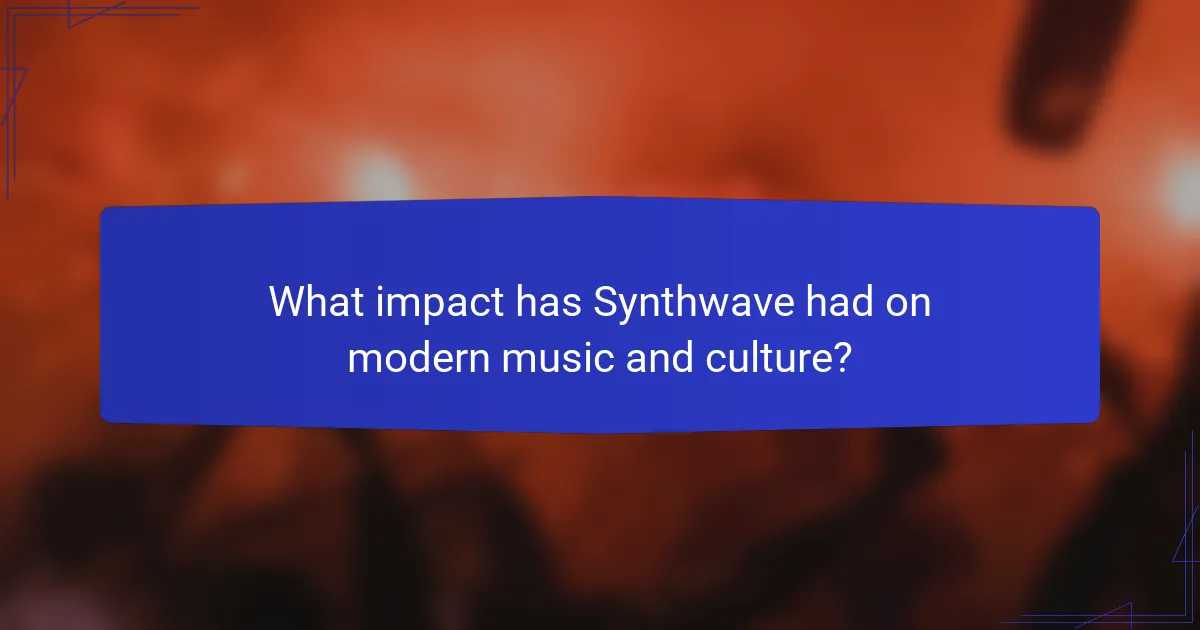
What impact has Synthwave had on modern music and culture?
Synthwave has significantly influenced modern music and culture. It has revived 1980s synth-driven sounds and aesthetics. This genre has inspired contemporary artists across various music styles. Notable artists like The Weeknd and Kavinsky incorporate synthwave elements in their work. The retro-futuristic visuals associated with synthwave have permeated fashion and art. Films and video games often use synthwave music to evoke nostalgia. The genre has fostered a dedicated community that celebrates retro culture. Synthwave’s impact is evident in the resurgence of cassette tapes and vintage synthesizers.
How has Synthwave influenced contemporary music genres?
Synthwave has significantly influenced contemporary music genres by reviving 1980s synth-pop sounds and aesthetics. Its use of retro synthesizers and drum machines has permeated various genres, including electronic, pop, and indie music. Artists like The Weeknd and Dua Lipa incorporate synthwave elements in their tracks, showcasing its mainstream appeal. The genre’s nostalgic themes resonate with listeners, creating a blend of old and new. Notably, the song “Blinding Lights” by The Weeknd topped charts globally, highlighting synthwave’s impact. Additionally, synthwave’s visual style has influenced music videos and album art, further embedding it in modern culture. This fusion of retro and contemporary has led to a resurgence of interest in electronic music.
What elements of Synthwave can be found in today’s popular music?
Synthwave elements in today’s popular music include retro synthesizers, drum machines, and nostalgic melodies. These elements evoke a sense of the 1980s aesthetic. Many contemporary artists incorporate lush synth pads and catchy hooks reminiscent of classic arcade games. The genre’s emphasis on atmospheric soundscapes is evident in tracks by artists like The Weeknd and Dua Lipa. Additionally, the use of neon visuals in music videos reflects the Synthwave influence. Popular songs often feature a blend of electronic and pop styles, showcasing Synthwave’s impact on modern production techniques. This fusion creates a unique listening experience that appeals to both new and nostalgic audiences.
How has the rise of Synthwave affected music production trends?
The rise of Synthwave has significantly influenced music production trends by reintroducing retro sounds and aesthetics. This genre emphasizes the use of synthesizers, drum machines, and nostalgic melodies reminiscent of the 1980s. Producers are increasingly utilizing analog equipment to achieve a warm, vintage sound. The popularity of digital audio workstations (DAWs) has also allowed for easy incorporation of Synthwave elements. Artists are blending Synthwave with contemporary genres, creating hybrid styles. This trend has led to a resurgence of interest in electronic music production techniques from past decades. Additionally, the visual aesthetics associated with Synthwave have inspired music videos and album artwork. The overall impact is a renewed focus on melody and atmosphere in modern music production.
What cultural phenomena are associated with the Synthwave movement?
The Synthwave movement is associated with various cultural phenomena, including retro-futurism and 1980s nostalgia. This genre draws heavily from 1980s pop culture, including films, video games, and fashion. Synthwave music often features synthesizers and electronic beats reminiscent of that era. Visual aesthetics in Synthwave include neon colors and grid patterns, often seen in album art and music videos. The movement has influenced fashion trends, with a resurgence of vintage clothing styles. Additionally, it has inspired a community of artists and creators who celebrate this aesthetic through various mediums. Events like synthwave festivals and online communities further promote this cultural phenomenon. The rise of platforms like Bandcamp and SoundCloud has facilitated the growth of Synthwave artists and audiences.
How has Synthwave influenced visual arts and fashion?
Synthwave has significantly influenced visual arts and fashion by reviving 1980s aesthetics. This genre emphasizes neon colors, retro-futuristic designs, and pixel art. Artists like Gunship and The Midnight incorporate these elements into their music videos and album covers. Fashion trends have mirrored this revival, featuring bold patterns and vintage silhouettes. Designers often draw inspiration from synthwave’s nostalgic themes. Events like the Synthwave Festival showcase fashion that reflects this unique style. The movement has also permeated digital art, with many artists creating synthwave-inspired pieces. Overall, synthwave’s impact is evident across multiple creative fields.
What role does nostalgia play in the popularity of Synthwave?
Nostalgia is a key factor in the popularity of Synthwave. This genre evokes memories of the 1980s through its distinct sound and aesthetic. Synthwave incorporates retro synthesizers, drum machines, and neon visuals. These elements resonate with listeners who grew up during that era. Studies indicate that nostalgia can enhance emotional well-being and foster a sense of belonging. The revival of 80s culture in media, such as films and video games, further amplifies this connection. As a result, Synthwave attracts both older fans and new listeners seeking a nostalgic experience.
What are some practical tips for exploring and enjoying Synthwave?
To explore and enjoy Synthwave, start by listening to foundational artists like Kavinsky and Perturbator. These artists define the genre’s sound. Create a playlist featuring key tracks to immerse yourself in the music. Attend live performances or synthwave festivals to experience the culture firsthand. Engage with online communities on platforms like Reddit or Discord to connect with other fans. Explore visual aesthetics through retro video games and 80s movies that inspire Synthwave. Consider creating your own music using software like FL Studio or Ableton Live to understand the genre better. Lastly, watch documentaries about Synthwave to gain deeper insights into its history and evolution.
How can listeners discover new Synthwave artists and tracks?
Listeners can discover new Synthwave artists and tracks through various platforms. Streaming services like Spotify and Apple Music often feature curated Synthwave playlists. These playlists are updated regularly, showcasing emerging artists. Social media platforms, such as Instagram and Twitter, allow fans to follow Synthwave artists and labels. Online communities on Reddit and Discord also share new music and recommendations. Music blogs dedicated to Synthwave provide reviews and highlight upcoming releases. Additionally, Bandcamp is a platform where many independent Synthwave artists share their work directly. These methods enable listeners to stay informed about the latest trends in the Synthwave genre.
What playlists or resources are recommended for Synthwave enthusiasts?
Recommended playlists for Synthwave enthusiasts include “Synthwave 2023” on Spotify, featuring contemporary artists. Another popular option is “Retrowave Essentials,” which showcases classic tracks in the genre. YouTube channels like “The 80s Guy” offer curated mixes and playlists. The website “Synthwave.co” provides resources and artist spotlights. Additionally, “NewRetroWave” on SoundCloud is known for its extensive collection of Synthwave tracks. These resources highlight the genre’s evolution and key artists. They serve as a great starting point for both new and seasoned fans.
Synthwave is a music genre that draws inspiration from 1980s synthesizer-driven music and pop culture, characterized by nostalgic soundscapes and retro-futuristic aesthetics. This article explores the historical context of Synthwave, its emergence as a musical genre, and the cultural movements that influenced it. Key artists such as Kavinsky and Gunship are highlighted for their contributions to the genre, along with the defining characteristics of Synthwave music, including its instrumentation and melodies. Additionally, the article examines the impact of Synthwave on modern music, culture, and visual arts, as well as practical tips for exploring and enjoying the genre.
